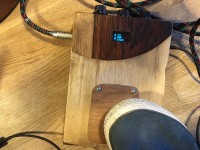Digital Stomper for Guitarists

Do you miss the beat, the four on the floor when the guitar player is alone on stage? What he needs is a stompbox.
You are a Guitar-Player and you would like to create Your own 4onthefloor by feet?
Many guitar-players have build a Stompbox and they have published their experience around building it.
Most times they use an old microphone or a piezo or an old pickup and put it into a box.
I had made first tests and started my project already last year but did not made a good progress because of needed time. While I was developing my Stompbox, new product got available on the market like the Roland SPK-Mini-Pads and the Ortega Horsekicks, all in a aceptable but high price-range.
I wanted to build the same but with a low-price ESP32.
I used a ESP32, an I2S-DAC PCM5102, a piezo, some resistors to build one. For further features I added already a I2C-OLED, 2 Rotary Encoders, a SD-Card-Reader and an traditional Power-Plug. (I had damaged already 2 ESP32-Boards because of too stiff USB-Wires for powering)
I used around 25 WAV-Files, converted them into hex/h-Files and added them to the Arduino project.
To play these hex-files I came along with a library from Erle Phil Hower III https://github.com/earlephilhower/ESP8266Audio. At that time, it was only available fro ESP8266. I ported it to ESP32 and added some gimmicks to change the way they play the sound to be more flexible.
The status of the project is "in progress" as I wanted to add Reverb, a Lowpass-Filter, SD-Card and some more gimmicks. The described prototype which is working is not velocity-sensitive because I am using only a switch. The piezo created a too wide variation of volume.
I have not given up with the Piezo but it needs a bit more electronics and time. I believe, the ADC of the ESP is a bit to fast and detects mostly single spikes of the piezo or I have to develop a Sample-and-Hold - stage.
It already created a lot of fun to play with a Stompbox because I could increase and decrease the tempo as I want to and in times playing only some single notes the audiants could still follow the beat.
In the prototype I used an I2C OLED0.96", a Rotary-Encoder with Push-Button and a single Button to provide a complete onscreen menu to change the sounds of the 20 presets and to modifiy the pitch and volume of it.
The final volume is adjustable with a normal potentiometer.
The used WAV-Files are mostly 16Bit, Mono and 44.1khz. Some samples where downsampled to 38Khz to get some more space int he system. The converted WAV-Files are not part of the sourcecode because I used commercial samples with copyright.
The project itsef, the used libraries and the progress of it is documented here:
https://github.com/ErichHeinemann/hman-stomper
I have added the last version of the Arduino-Library here at elektor!
Many thanks to elektor for all the cool projects in the past!
.. my first Elektor was from around 1984
Many guitar-players have build a Stompbox and they have published their experience around building it.
Most times they use an old microphone or a piezo or an old pickup and put it into a box.
I had made first tests and started my project already last year but did not made a good progress because of needed time. While I was developing my Stompbox, new product got available on the market like the Roland SPK-Mini-Pads and the Ortega Horsekicks, all in a aceptable but high price-range.
I wanted to build the same but with a low-price ESP32.
I used a ESP32, an I2S-DAC PCM5102, a piezo, some resistors to build one. For further features I added already a I2C-OLED, 2 Rotary Encoders, a SD-Card-Reader and an traditional Power-Plug. (I had damaged already 2 ESP32-Boards because of too stiff USB-Wires for powering)
I used around 25 WAV-Files, converted them into hex/h-Files and added them to the Arduino project.
To play these hex-files I came along with a library from Erle Phil Hower III https://github.com/earlephilhower/ESP8266Audio. At that time, it was only available fro ESP8266. I ported it to ESP32 and added some gimmicks to change the way they play the sound to be more flexible.
The status of the project is "in progress" as I wanted to add Reverb, a Lowpass-Filter, SD-Card and some more gimmicks. The described prototype which is working is not velocity-sensitive because I am using only a switch. The piezo created a too wide variation of volume.
I have not given up with the Piezo but it needs a bit more electronics and time. I believe, the ADC of the ESP is a bit to fast and detects mostly single spikes of the piezo or I have to develop a Sample-and-Hold - stage.
It already created a lot of fun to play with a Stompbox because I could increase and decrease the tempo as I want to and in times playing only some single notes the audiants could still follow the beat.
In the prototype I used an I2C OLED0.96", a Rotary-Encoder with Push-Button and a single Button to provide a complete onscreen menu to change the sounds of the 20 presets and to modifiy the pitch and volume of it.
The final volume is adjustable with a normal potentiometer.
The used WAV-Files are mostly 16Bit, Mono and 44.1khz. Some samples where downsampled to 38Khz to get some more space int he system. The converted WAV-Files are not part of the sourcecode because I used commercial samples with copyright.
The project itsef, the used libraries and the progress of it is documented here:
https://github.com/ErichHeinemann/hman-stomper
I have added the last version of the Arduino-Library here at elektor!
Many thanks to elektor for all the cool projects in the past!
.. my first Elektor was from around 1984




Discussion (3 commentaire(s))